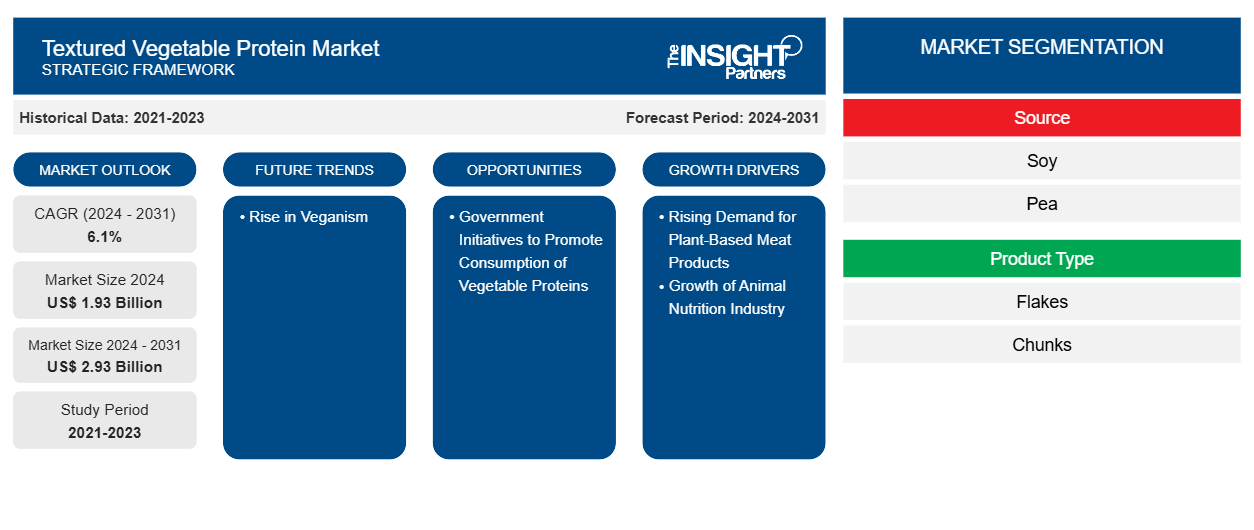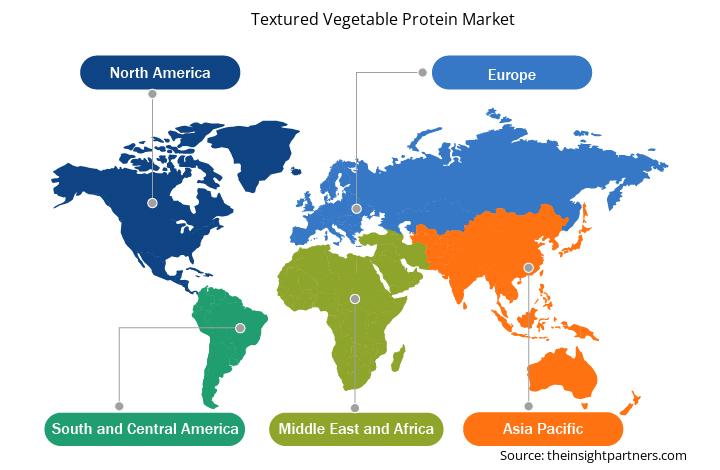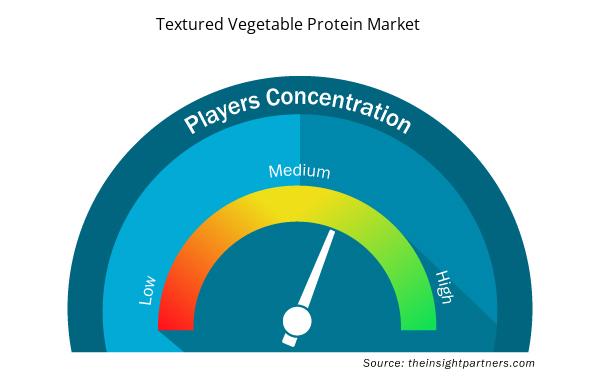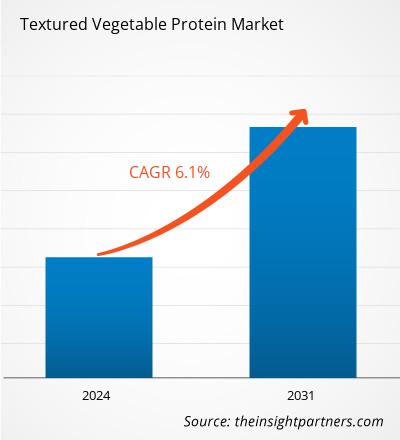预计到 2031 年,组织化植物蛋白市场规模将从 2024 年的 19.3 亿美元增至 29.3 亿美元。预计 2024-2031 年期间,该市场的复合年增长率将达到 6.1%。在预测期内,素食主义的兴起可能会给市场带来新的趋势。
组织化植物蛋白市场分析
植物性肉类产品需求的不断增长和动物营养行业的增长是推动市场发展的关键因素。一些营养师和健康从业者建议减少肉类消费,改吃素食,以降低肥胖、心脏病、高血压和消化系统疾病等慢性健康问题的风险。根据植物性食品协会 (PBFA) 的数据,去年消费者需求有所上升:2021 年有 19% 的家庭购买了植物性肉类——高于 2020 年的 18%——其中令人印象深刻的是 64% 的买家全年多次购买。Veganuary(一个鼓励全世界的个人在整个 1 月份成为素食主义者的非营利组织)发布的一份报告指出,2021 年约有 580 万人报名参加 Veganuary 活动。因此,全球素食主义的兴起预计将在未来几年在纹理化植物蛋白市场创造新的趋势。
组织化植物蛋白市场概况
由于大规模的公众意识倡议和宣传活动,北美民众对频繁食用肉类有害影响的认识有所提高。消费者偏好转向健康和营养食品,这导致对纯素、无麸质、高纤维、高蛋白或低热量食品的需求激增。由于该国心血管疾病和肥胖症的患病率很高,消费者倾向于以植物为基础的健康饮食,包括高蛋白饮食和低脂植物蛋白,如纹理化植物蛋白。这种蛋白质还富含纤维,可降低胆固醇水平和血压。
定制此报告以满足您的需求
您可以免费定制任何报告,包括本报告的部分内容、国家级分析、Excel 数据包,以及为初创企业和大学提供优惠和折扣
组织化植物蛋白市场:

- 获取此报告的关键市场趋势。这个免费样品将包括数据分析,从市场趋势到估计和预测。
组织化植物蛋白市场驱动因素和机遇
植物肉制品需求不断增长
研究显示,经常食用肉类会增加患糖尿病的风险。非政府组织 ProVeg International 称,牛津大学对 474,000 多人进行的一项研究发现,每天食用 70 克未加工的红肉(如牛肉或猪肉)和加工肉类(如培根、香肠或火腿)会使患 2 型糖尿病的风险增加 30%。此外,食用植物性食物可以降低胰岛素抵抗、糖尿病前期和 2 型糖尿病的风险。这凸显了养成可持续饮食习惯的好处。因此,对植物性肉制品的需求不断增长,推动了纹理化植物蛋白市场的增长。
政府推动植物蛋白消费的举措
由于植物肉对环境的关注度不断上升,且对健康有益,各国政府机构都在推动植物肉的消费。此外,各国政府也在积极投资植物肉产品的研发和新产品的推出。一些国家已经宣布投资植物蛋白和组织化植物蛋白等肉类替代成分。因此,预计政府推动肉类替代产品消费的举措将在预测期内为市场增长创造丰厚的机会。
组织化植物蛋白市场报告细分分析
有助于得出组织化植物蛋白市场分析的关键部分是来源、产品类型、类别和应用。
- 根据来源,市场分为大豆、豌豆和其他。大豆部分在 2024 年占据市场主导地位。
- 根据产品类型,市场分为薄片、块状和其他类型。薄片部分在 2024 年占据了最大的市场份额。
- 根据类别,市场分为有机和常规。2024 年,常规部分占据市场主导地位。
- 根据应用,市场分为食品和饮料(肉类和肉类替代品、甜味和咸味小吃、烘焙和糖果等)和动物营养。食品和饮料部门在 2024 年占据了更大的市场份额。
组织化植物蛋白市场份额(按地区)分析
组织化植物蛋白市场报告的地理范围主要分为五个区域:北美、亚太、欧洲、中东和非洲、南美和中美。
欧洲主导着纹理化植物蛋白市场。欧洲越来越重视健康和保健,从而提高了人们对均衡饮食重要性的认识。纹理化植物蛋白用于制作肉类替代品或肉类替代品。根据 Good Food Institute 的数据,德国是植物性产品的最大消费国,其次是英国、意大利、西班牙和法国。根据联邦农业和食品局 (BLE) 的数据,德国动物性食品消费量持续下降,2022 年肉类消费量下降了约 8%,至每人 52 公斤。
组织化植物蛋白市场区域洞察
Insight Partners 的分析师已详尽解释了预测期内影响纹理植物蛋白市场的区域趋势和因素。本节还讨论了北美、欧洲、亚太地区、中东和非洲以及南美和中美洲的纹理植物蛋白市场细分和地理位置。

- 获取纹理植物蛋白市场的区域特定数据
组织植物蛋白市场报告范围
| 报告属性 | 细节 |
|---|---|
| 2024 年的市场规模 | 19.3亿美元 |
| 2031 年市场规模 | 29.3亿美元 |
| 全球复合年增长率(2024 - 2031) | 6.1% |
| 史料 | 2021-2023 |
| 预测期 | 2024-2031 |
| 涵盖的领域 | 按来源
|
| 覆盖地区和国家 | 北美
|
| 市场领导者和主要公司简介 |
|
纹理植物蛋白市场参与者密度:了解其对业务动态的影响
纹理植物蛋白市场正在快速增长,这得益于终端用户需求的不断增长,而这些需求又源于消费者偏好的不断变化、技术进步以及对产品优势的认识不断提高等因素。随着需求的增加,企业正在扩大其产品范围,进行创新以满足消费者的需求,并利用新兴趋势,从而进一步推动市场增长。
市场参与者密度是指在特定市场或行业内运营的企业或公司的分布情况。它表明在给定市场空间中,相对于其规模或总市场价值,有多少竞争对手(市场参与者)存在。
在组织化植物蛋白市场运营的主要公司有:
- 阿彻丹尼尔斯米德兰公司
- 嘉吉公司
- 宜瑞安公司
- 罗盖特兄弟公司
- 国际香精香料公司
- MGP 配料公司
免责声明:上面列出的公司没有按照任何特定顺序排列。

- 了解纹理植物蛋白市场顶级关键参与者概况
组织化植物蛋白市场新闻及最新发展
通过收集一手和二手资料后获得的定性和定量数据来评估组织化植物蛋白市场,这些资料包括重要的公司出版物、协会数据和数据库。以下列出了市场的一些发展情况:
- Ingredion 推出 VITESSENCE Pea 200 D,彻底改变了营养饮料的饮用体验。(来源:Ingredion,新闻稿,2024 年 10 月)
- Ingredion 推出了一种新型豌豆蛋白,可使冷榨棒在整个保质期内保持柔软度。(来源:Ingredion,新闻稿,2024 年 7 月)
- 罗盖特推出四种多功能豌豆蛋白,开拓植物蛋白市场。这些蛋白质旨在改善植物性食品和高蛋白营养产品的口感、质地和创造力。(来源:罗盖特,新闻稿,2024 年 2 月)
组织化植物蛋白市场报告覆盖范围和交付成果
“组织化植物蛋白市场规模和预测(2021-2031)”报告对以下领域进行了详细的市场分析:
- 组织化植物蛋白市场规模及全球、区域和国家层面所有主要细分市场的预测
- 纹理植物蛋白市场趋势以及市场动态,如驱动因素、限制因素和关键机遇
- 详细的波特五力分析和 SWOT 分析
- 组织化植物蛋白市场分析涵盖主要市场趋势、全球和区域框架、主要参与者、法规和最新市场发展
- 行业格局和竞争分析,涵盖市场集中度、热图分析、知名参与者以及市场最新发展
- 详细的公司简介
- 历史分析(2 年)、基准年、预测(7 年)及复合年增长率
- PEST 和 SWOT 分析
- 市场规模价值/数量 - 全球、区域、国家
- 行业和竞争格局
- Excel 数据集


- Medical Second Opinion Market
- Advanced Planning and Scheduling Software Market
- Underwater Connector Market
- Joint Pain Injection Market
- Pressure Vessel Composite Materials Market
- Volumetric Video Market
- Hydrolyzed Collagen Market
- Predictive Maintenance Market
- Photo Editing Software Market
- UV Curing System Market

Report Coverage
Revenue forecast, Company Analysis, Industry landscape, Growth factors, and Trends

Segment Covered
This text is related
to segments covered.

Regional Scope
North America, Europe, Asia Pacific, Middle East & Africa, South & Central America

Country Scope
This text is related
to country scope.
常见问题
The market is expected to register a CAGR of 6.1% during 2024–2031.
The market value is estimated to be US$ 2.93 billion by 2031.
Rising demand for plant-based meat products and growth of animal nutrition industry are among the factors accelerating the textured vegetable protein market growth.
Archer-Daniels-Midland Co, Cargill Inc, Ingredion Inc, Roquette Freres SA, and International Flavors & Fragrances Inc are among the leading players operating in the textured vegetable protein market.
The rise in veganism is likely to set new market trends in the coming years.
Europe dominated the textured vegetable protein market in 2024.
Trends and growth analysis reports related to Food and Beverages : READ MORE..
The List of Companies - Textured Vegetable Protein Market
- Archer-Daniels-Midland Co
- Cargill Inc
- Ingredion Inc
- Roquette Freres SA
- International Flavors & Fragrances Inc
- MGP Ingredients Inc
- Puris
- DSM-Firmenich AG
- Axiom Foods Inc
- Foodchem International Corp
The Insight Partners performs research in 4 major stages: Data Collection & Secondary Research, Primary Research, Data Analysis and Data Triangulation & Final Review.
- Data Collection and Secondary Research:
As a market research and consulting firm operating from a decade, we have published and advised several client across the globe. First step for any study will start with an assessment of currently available data and insights from existing reports. Further, historical and current market information is collected from Investor Presentations, Annual Reports, SEC Filings, etc., and other information related to company’s performance and market positioning are gathered from Paid Databases (Factiva, Hoovers, and Reuters) and various other publications available in public domain.
Several associations trade associates, technical forums, institutes, societies and organization are accessed to gain technical as well as market related insights through their publications such as research papers, blogs and press releases related to the studies are referred to get cues about the market. Further, white papers, journals, magazines, and other news articles published in last 3 years are scrutinized and analyzed to understand the current market trends.
- Primary Research:
The primarily interview analysis comprise of data obtained from industry participants interview and answers to survey questions gathered by in-house primary team.
For primary research, interviews are conducted with industry experts/CEOs/Marketing Managers/VPs/Subject Matter Experts from both demand and supply side to get a 360-degree view of the market. The primary team conducts several interviews based on the complexity of the markets to understand the various market trends and dynamics which makes research more credible and precise.
A typical research interview fulfils the following functions:
- Provides first-hand information on the market size, market trends, growth trends, competitive landscape, and outlook
- Validates and strengthens in-house secondary research findings
- Develops the analysis team’s expertise and market understanding
Primary research involves email interactions and telephone interviews for each market, category, segment, and sub-segment across geographies. The participants who typically take part in such a process include, but are not limited to:
- Industry participants: VPs, business development managers, market intelligence managers and national sales managers
- Outside experts: Valuation experts, research analysts and key opinion leaders specializing in the electronics and semiconductor industry.
Below is the breakup of our primary respondents by company, designation, and region:

Once we receive the confirmation from primary research sources or primary respondents, we finalize the base year market estimation and forecast the data as per the macroeconomic and microeconomic factors assessed during data collection.
- Data Analysis:
Once data is validated through both secondary as well as primary respondents, we finalize the market estimations by hypothesis formulation and factor analysis at regional and country level.
- Macro-Economic Factor Analysis:
We analyse macroeconomic indicators such the gross domestic product (GDP), increase in the demand for goods and services across industries, technological advancement, regional economic growth, governmental policies, the influence of COVID-19, PEST analysis, and other aspects. This analysis aids in setting benchmarks for various nations/regions and approximating market splits. Additionally, the general trend of the aforementioned components aid in determining the market's development possibilities.
- Country Level Data:
Various factors that are especially aligned to the country are taken into account to determine the market size for a certain area and country, including the presence of vendors, such as headquarters and offices, the country's GDP, demand patterns, and industry growth. To comprehend the market dynamics for the nation, a number of growth variables, inhibitors, application areas, and current market trends are researched. The aforementioned elements aid in determining the country's overall market's growth potential.
- Company Profile:
The “Table of Contents” is formulated by listing and analyzing more than 25 - 30 companies operating in the market ecosystem across geographies. However, we profile only 10 companies as a standard practice in our syndicate reports. These 10 companies comprise leading, emerging, and regional players. Nonetheless, our analysis is not restricted to the 10 listed companies, we also analyze other companies present in the market to develop a holistic view and understand the prevailing trends. The “Company Profiles” section in the report covers key facts, business description, products & services, financial information, SWOT analysis, and key developments. The financial information presented is extracted from the annual reports and official documents of the publicly listed companies. Upon collecting the information for the sections of respective companies, we verify them via various primary sources and then compile the data in respective company profiles. The company level information helps us in deriving the base number as well as in forecasting the market size.
- Developing Base Number:
Aggregation of sales statistics (2020-2022) and macro-economic factor, and other secondary and primary research insights are utilized to arrive at base number and related market shares for 2022. The data gaps are identified in this step and relevant market data is analyzed, collected from paid primary interviews or databases. On finalizing the base year market size, forecasts are developed on the basis of macro-economic, industry and market growth factors and company level analysis.
- Data Triangulation and Final Review:
The market findings and base year market size calculations are validated from supply as well as demand side. Demand side validations are based on macro-economic factor analysis and benchmarks for respective regions and countries. In case of supply side validations, revenues of major companies are estimated (in case not available) based on industry benchmark, approximate number of employees, product portfolio, and primary interviews revenues are gathered. Further revenue from target product/service segment is assessed to avoid overshooting of market statistics. In case of heavy deviations between supply and demand side values, all thes steps are repeated to achieve synchronization.
We follow an iterative model, wherein we share our research findings with Subject Matter Experts (SME’s) and Key Opinion Leaders (KOLs) until consensus view of the market is not formulated – this model negates any drastic deviation in the opinions of experts. Only validated and universally acceptable research findings are quoted in our reports.
We have important check points that we use to validate our research findings – which we call – data triangulation, where we validate the information, we generate from secondary sources with primary interviews and then we re-validate with our internal data bases and Subject matter experts. This comprehensive model enables us to deliver high quality, reliable data in shortest possible time.

 获取此报告的免费样本
获取此报告的免费样本